Statistics of Business and Finance: Stock Analysis and CAPM
VerifiedAdded on 2023/06/04
|9
|1305
|320
Homework Assignment
AI Summary
This assignment focuses on the statistical analysis of stock returns for Boeing Company and General Dynamics. It involves computing monthly returns, testing for normality using the Jarque-Bera test, and conducting hypothesis tests to compare returns and risks. The analysis includes t-tests, F-tests, and the application of the CAPM model to determine beta, the coefficient of determination, and confidence intervals. The assignment concludes with interpretations of the statistical results, including the significance of differences in risk and return, the interpretation of beta, and an assessment of the model's fit. The student concludes that General Dynamics stock is preferred due to its higher average returns and lower risk. The normality of the residuals from the CAPM model is also assessed.
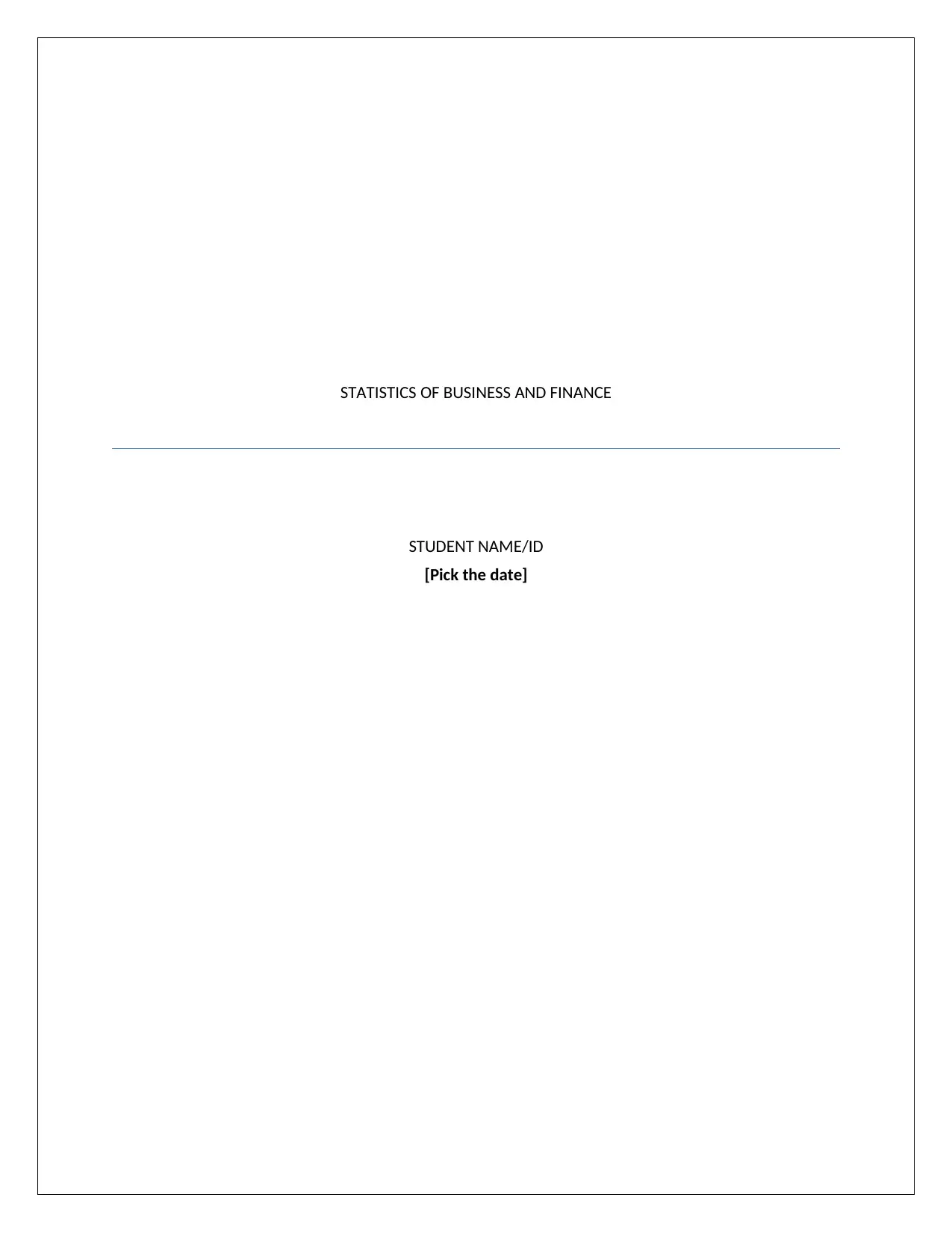
STATISTICS OF BUSINESS AND FINANCE
STUDENT NAME/ID
[Pick the date]
STUDENT NAME/ID
[Pick the date]
Paraphrase This Document
Need a fresh take? Get an instant paraphrase of this document with our AI Paraphraser
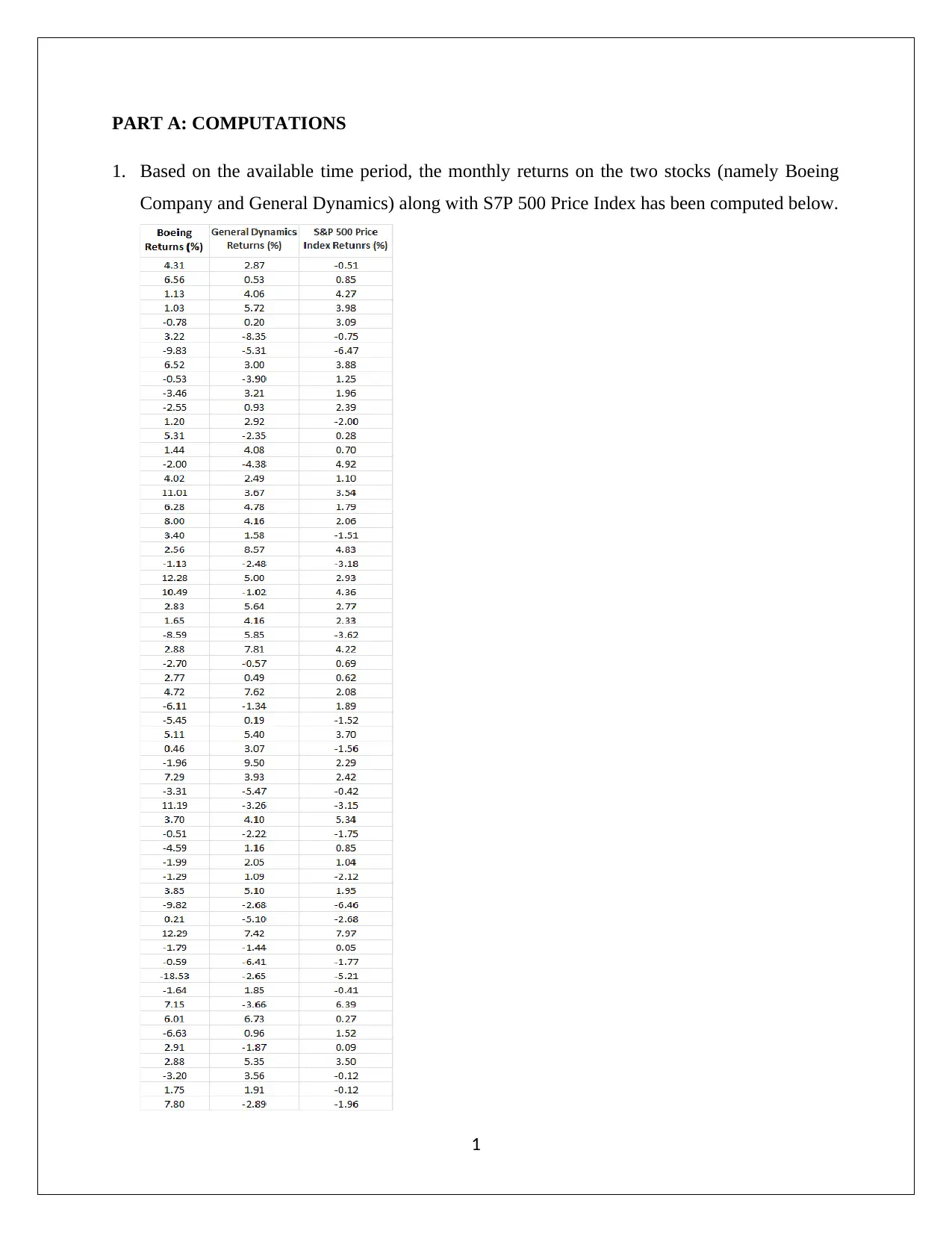
PART A: COMPUTATIONS
1. Based on the available time period, the monthly returns on the two stocks (namely Boeing
Company and General Dynamics) along with S7P 500 Price Index has been computed below.
1
1. Based on the available time period, the monthly returns on the two stocks (namely Boeing
Company and General Dynamics) along with S7P 500 Price Index has been computed below.
1
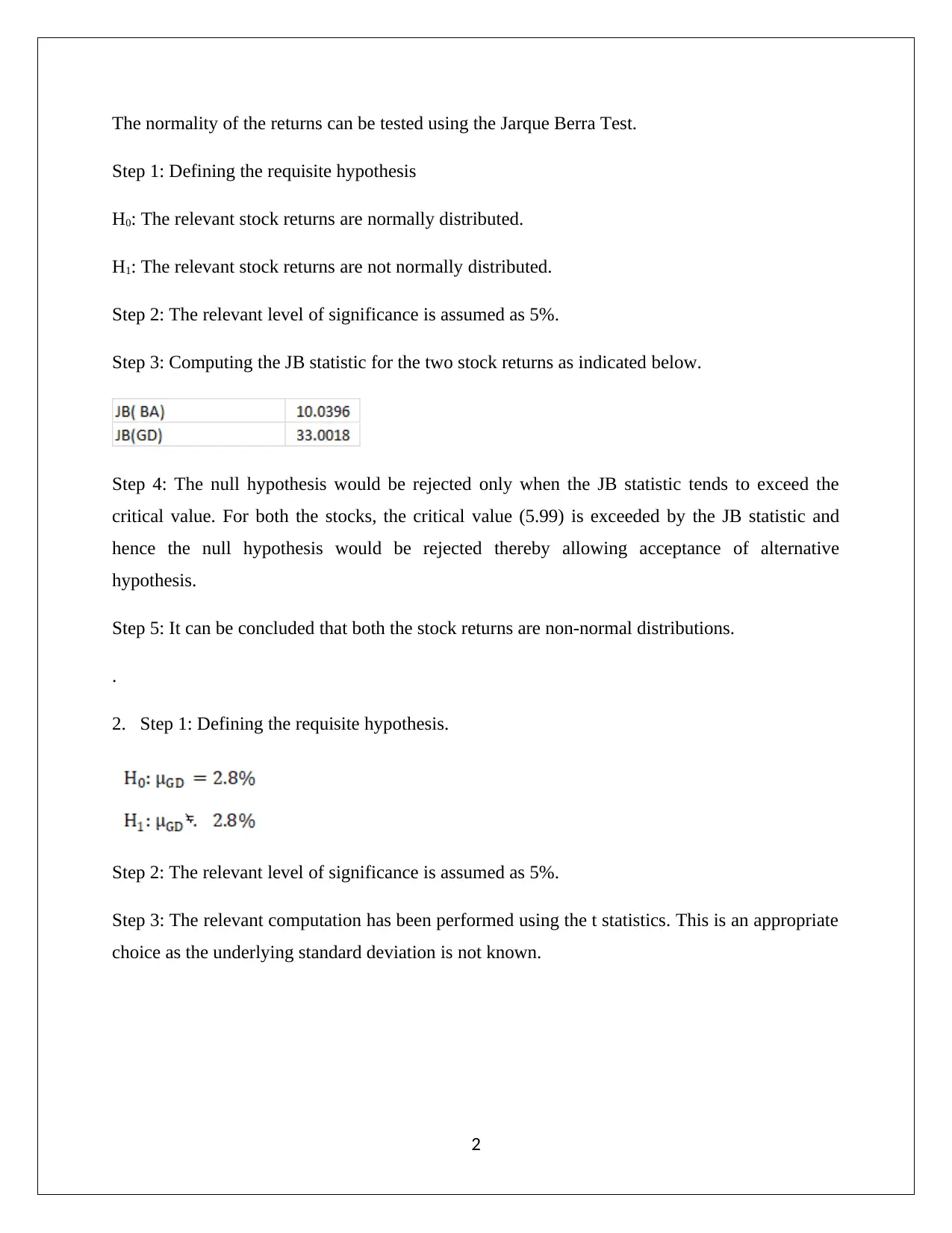
The normality of the returns can be tested using the Jarque Berra Test.
Step 1: Defining the requisite hypothesis
H0: The relevant stock returns are normally distributed.
H1: The relevant stock returns are not normally distributed.
Step 2: The relevant level of significance is assumed as 5%.
Step 3: Computing the JB statistic for the two stock returns as indicated below.
Step 4: The null hypothesis would be rejected only when the JB statistic tends to exceed the
critical value. For both the stocks, the critical value (5.99) is exceeded by the JB statistic and
hence the null hypothesis would be rejected thereby allowing acceptance of alternative
hypothesis.
Step 5: It can be concluded that both the stock returns are non-normal distributions.
.
2. Step 1: Defining the requisite hypothesis.
Step 2: The relevant level of significance is assumed as 5%.
Step 3: The relevant computation has been performed using the t statistics. This is an appropriate
choice as the underlying standard deviation is not known.
2
Step 1: Defining the requisite hypothesis
H0: The relevant stock returns are normally distributed.
H1: The relevant stock returns are not normally distributed.
Step 2: The relevant level of significance is assumed as 5%.
Step 3: Computing the JB statistic for the two stock returns as indicated below.
Step 4: The null hypothesis would be rejected only when the JB statistic tends to exceed the
critical value. For both the stocks, the critical value (5.99) is exceeded by the JB statistic and
hence the null hypothesis would be rejected thereby allowing acceptance of alternative
hypothesis.
Step 5: It can be concluded that both the stock returns are non-normal distributions.
.
2. Step 1: Defining the requisite hypothesis.
Step 2: The relevant level of significance is assumed as 5%.
Step 3: The relevant computation has been performed using the t statistics. This is an appropriate
choice as the underlying standard deviation is not known.
2
⊘ This is a preview!⊘
Do you want full access?
Subscribe today to unlock all pages.

Trusted by 1+ million students worldwide
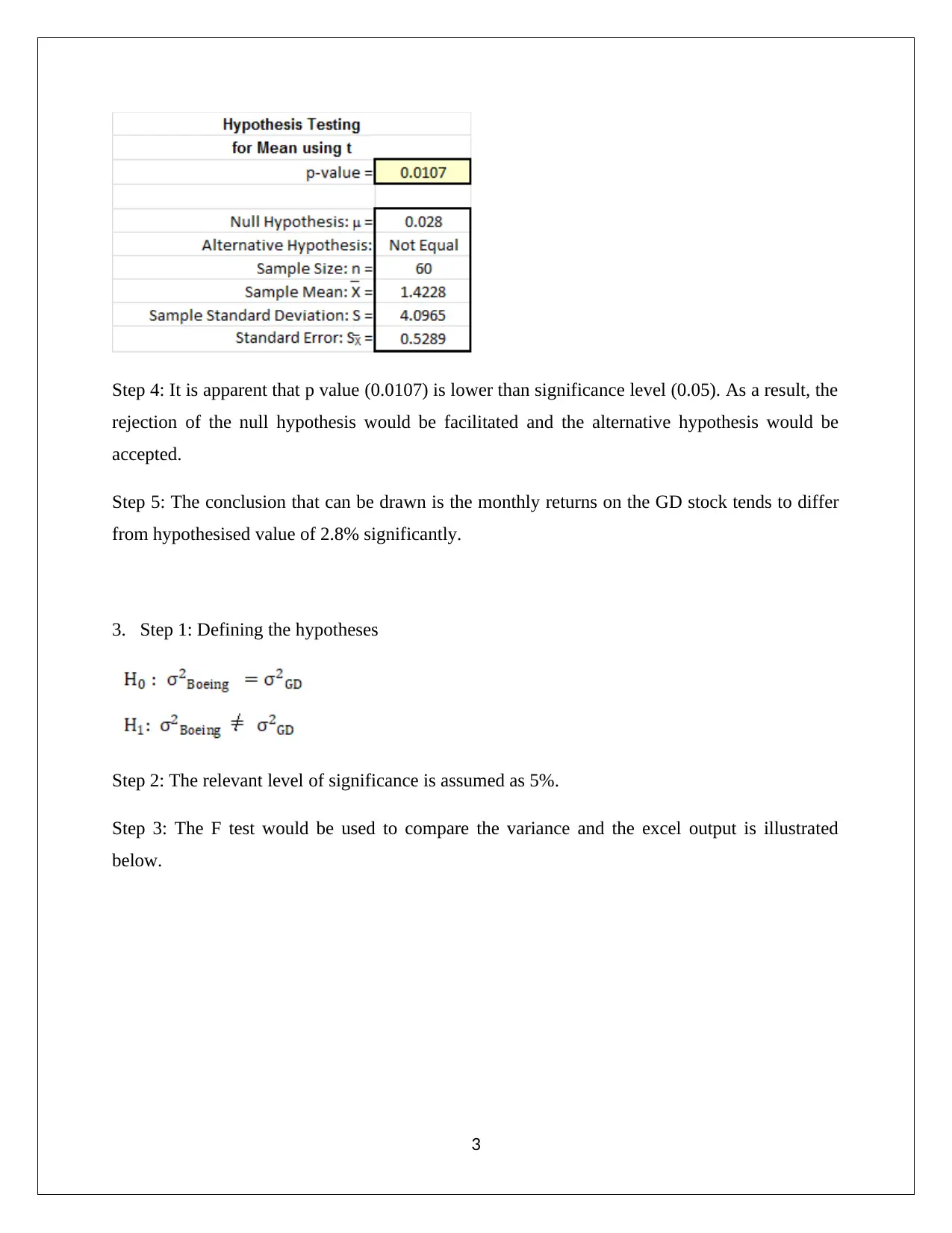
Step 4: It is apparent that p value (0.0107) is lower than significance level (0.05). As a result, the
rejection of the null hypothesis would be facilitated and the alternative hypothesis would be
accepted.
Step 5: The conclusion that can be drawn is the monthly returns on the GD stock tends to differ
from hypothesised value of 2.8% significantly.
3. Step 1: Defining the hypotheses
Step 2: The relevant level of significance is assumed as 5%.
Step 3: The F test would be used to compare the variance and the excel output is illustrated
below.
3
rejection of the null hypothesis would be facilitated and the alternative hypothesis would be
accepted.
Step 5: The conclusion that can be drawn is the monthly returns on the GD stock tends to differ
from hypothesised value of 2.8% significantly.
3. Step 1: Defining the hypotheses
Step 2: The relevant level of significance is assumed as 5%.
Step 3: The F test would be used to compare the variance and the excel output is illustrated
below.
3
Paraphrase This Document
Need a fresh take? Get an instant paraphrase of this document with our AI Paraphraser

Step 4: The relevant p value would be 0.0043*2 = 0.0086. Considering that this is lower than the
level of significance, hence the null hypothesis rejection would tend to take place paving way for
acceptance of alternative hypothesises.
Step 5: It would be fair to conclude that that the two stock risks do tend to possess a significant
difference.
4. Step 1: Defining the Hypotheses
Step 2: The relevant level of significance is assumed as 5%.
Step 3: The returns for the two stocks are not dependent on each other and also the population
standard deviation for both the given stocks is not known which allows the use of t statistics. The
Excel output for the appropriate test is as indicated below.
4
level of significance, hence the null hypothesis rejection would tend to take place paving way for
acceptance of alternative hypothesises.
Step 5: It would be fair to conclude that that the two stock risks do tend to possess a significant
difference.
4. Step 1: Defining the Hypotheses
Step 2: The relevant level of significance is assumed as 5%.
Step 3: The returns for the two stocks are not dependent on each other and also the population
standard deviation for both the given stocks is not known which allows the use of t statistics. The
Excel output for the appropriate test is as indicated below.
4
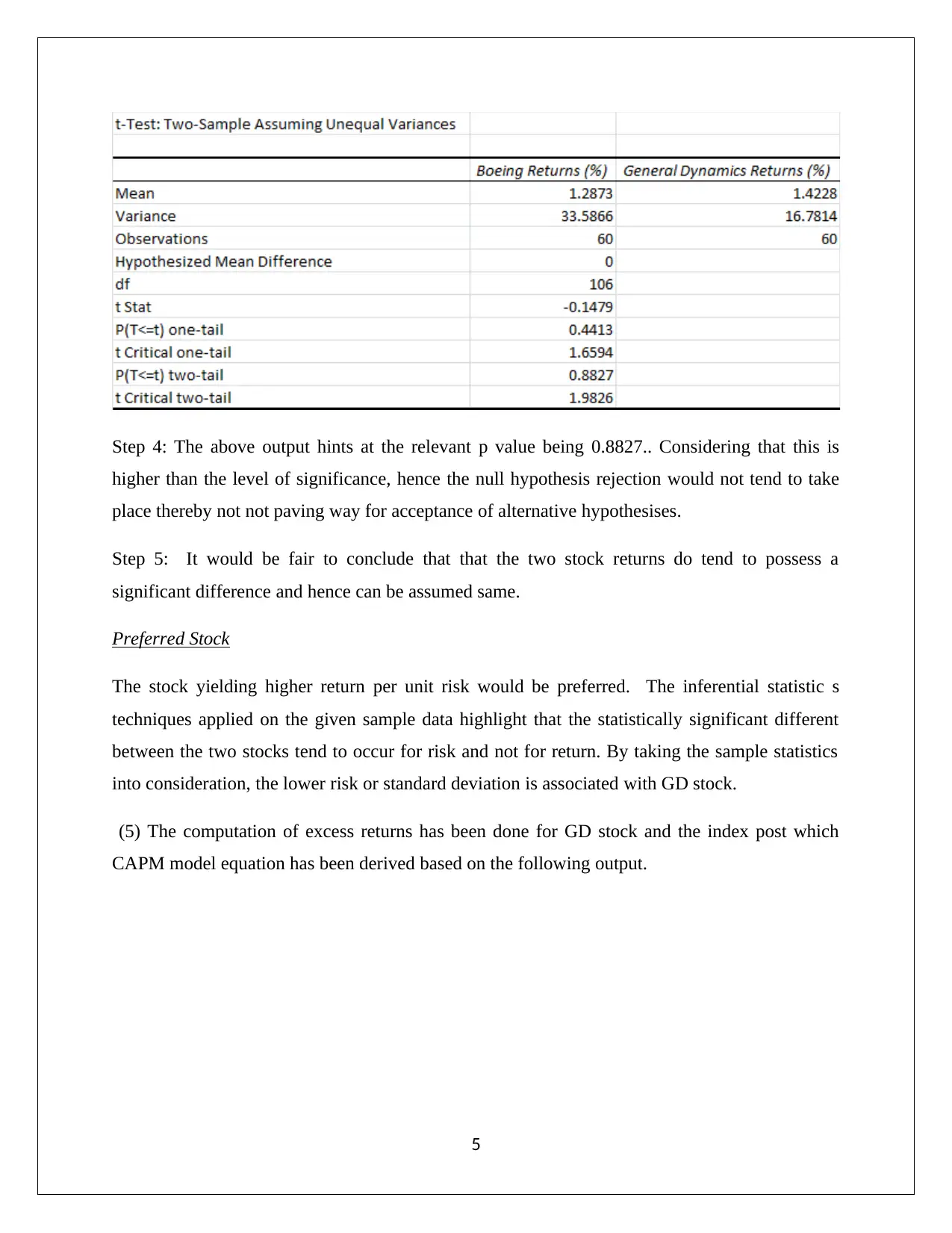
Step 4: The above output hints at the relevant p value being 0.8827.. Considering that this is
higher than the level of significance, hence the null hypothesis rejection would not tend to take
place thereby not not paving way for acceptance of alternative hypothesises.
Step 5: It would be fair to conclude that that the two stock returns do tend to possess a
significant difference and hence can be assumed same.
Preferred Stock
The stock yielding higher return per unit risk would be preferred. The inferential statistic s
techniques applied on the given sample data highlight that the statistically significant different
between the two stocks tend to occur for risk and not for return. By taking the sample statistics
into consideration, the lower risk or standard deviation is associated with GD stock.
(5) The computation of excess returns has been done for GD stock and the index post which
CAPM model equation has been derived based on the following output.
5
higher than the level of significance, hence the null hypothesis rejection would not tend to take
place thereby not not paving way for acceptance of alternative hypothesises.
Step 5: It would be fair to conclude that that the two stock returns do tend to possess a
significant difference and hence can be assumed same.
Preferred Stock
The stock yielding higher return per unit risk would be preferred. The inferential statistic s
techniques applied on the given sample data highlight that the statistically significant different
between the two stocks tend to occur for risk and not for return. By taking the sample statistics
into consideration, the lower risk or standard deviation is associated with GD stock.
(5) The computation of excess returns has been done for GD stock and the index post which
CAPM model equation has been derived based on the following output.
5
⊘ This is a preview!⊘
Do you want full access?
Subscribe today to unlock all pages.

Trusted by 1+ million students worldwide
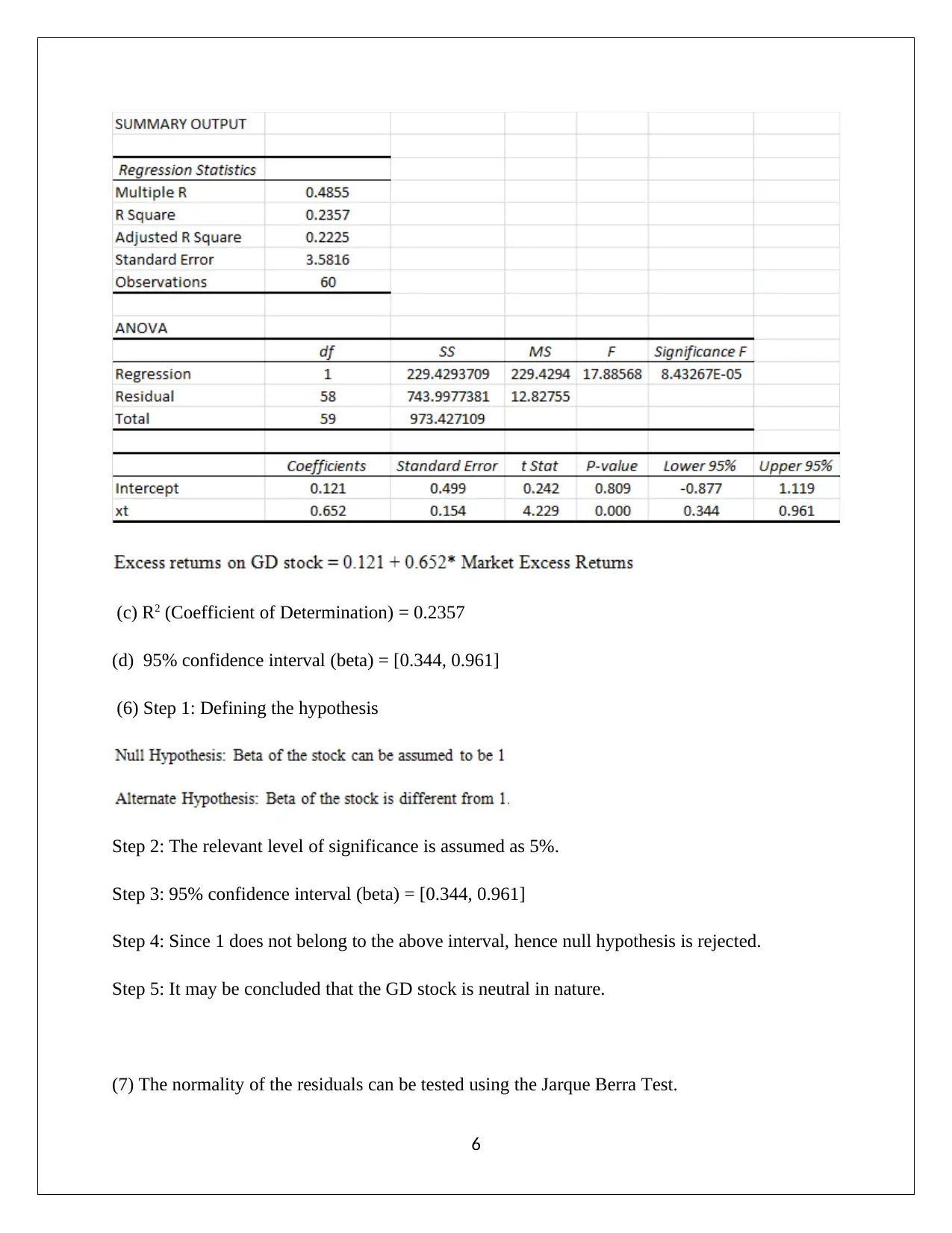
(c) R2 (Coefficient of Determination) = 0.2357
(d) 95% confidence interval (beta) = [0.344, 0.961]
(6) Step 1: Defining the hypothesis
Step 2: The relevant level of significance is assumed as 5%.
Step 3: 95% confidence interval (beta) = [0.344, 0.961]
Step 4: Since 1 does not belong to the above interval, hence null hypothesis is rejected.
Step 5: It may be concluded that the GD stock is neutral in nature.
(7) The normality of the residuals can be tested using the Jarque Berra Test.
6
(d) 95% confidence interval (beta) = [0.344, 0.961]
(6) Step 1: Defining the hypothesis
Step 2: The relevant level of significance is assumed as 5%.
Step 3: 95% confidence interval (beta) = [0.344, 0.961]
Step 4: Since 1 does not belong to the above interval, hence null hypothesis is rejected.
Step 5: It may be concluded that the GD stock is neutral in nature.
(7) The normality of the residuals can be tested using the Jarque Berra Test.
6
Paraphrase This Document
Need a fresh take? Get an instant paraphrase of this document with our AI Paraphraser
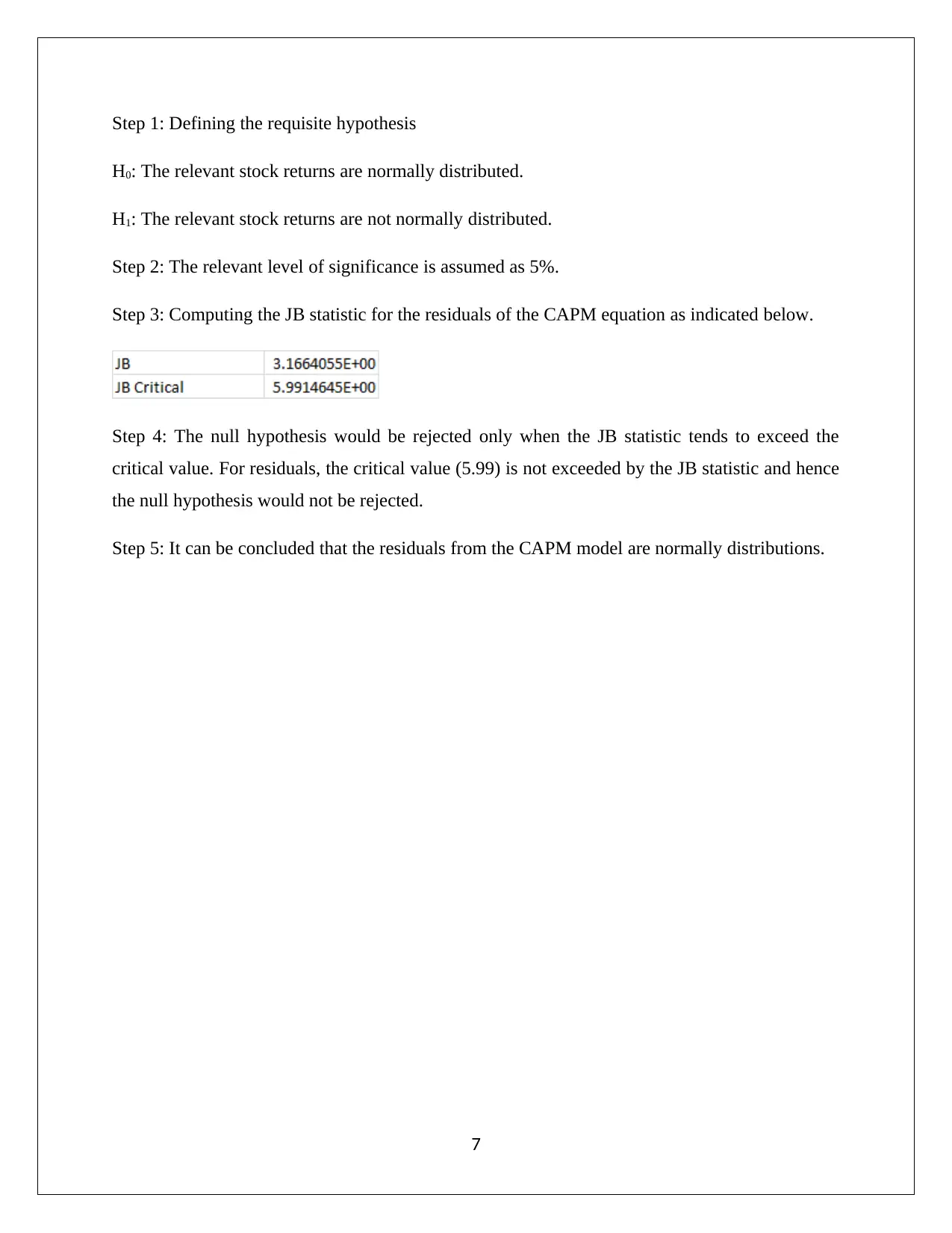
Step 1: Defining the requisite hypothesis
H0: The relevant stock returns are normally distributed.
H1: The relevant stock returns are not normally distributed.
Step 2: The relevant level of significance is assumed as 5%.
Step 3: Computing the JB statistic for the residuals of the CAPM equation as indicated below.
Step 4: The null hypothesis would be rejected only when the JB statistic tends to exceed the
critical value. For residuals, the critical value (5.99) is not exceeded by the JB statistic and hence
the null hypothesis would not be rejected.
Step 5: It can be concluded that the residuals from the CAPM model are normally distributions.
7
H0: The relevant stock returns are normally distributed.
H1: The relevant stock returns are not normally distributed.
Step 2: The relevant level of significance is assumed as 5%.
Step 3: Computing the JB statistic for the residuals of the CAPM equation as indicated below.
Step 4: The null hypothesis would be rejected only when the JB statistic tends to exceed the
critical value. For residuals, the critical value (5.99) is not exceeded by the JB statistic and hence
the null hypothesis would not be rejected.
Step 5: It can be concluded that the residuals from the CAPM model are normally distributions.
7
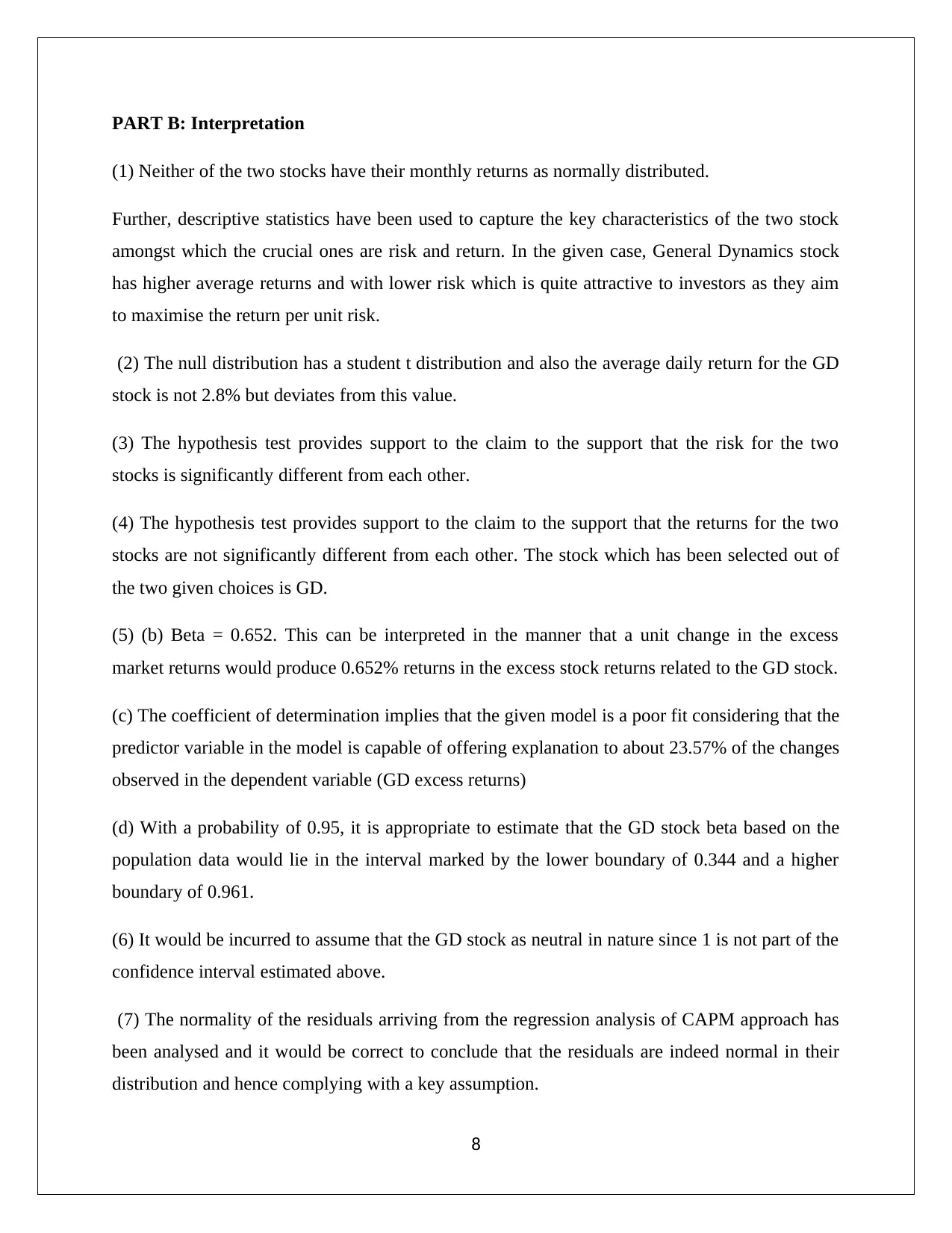
PART B: Interpretation
(1) Neither of the two stocks have their monthly returns as normally distributed.
Further, descriptive statistics have been used to capture the key characteristics of the two stock
amongst which the crucial ones are risk and return. In the given case, General Dynamics stock
has higher average returns and with lower risk which is quite attractive to investors as they aim
to maximise the return per unit risk.
(2) The null distribution has a student t distribution and also the average daily return for the GD
stock is not 2.8% but deviates from this value.
(3) The hypothesis test provides support to the claim to the support that the risk for the two
stocks is significantly different from each other.
(4) The hypothesis test provides support to the claim to the support that the returns for the two
stocks are not significantly different from each other. The stock which has been selected out of
the two given choices is GD.
(5) (b) Beta = 0.652. This can be interpreted in the manner that a unit change in the excess
market returns would produce 0.652% returns in the excess stock returns related to the GD stock.
(c) The coefficient of determination implies that the given model is a poor fit considering that the
predictor variable in the model is capable of offering explanation to about 23.57% of the changes
observed in the dependent variable (GD excess returns)
(d) With a probability of 0.95, it is appropriate to estimate that the GD stock beta based on the
population data would lie in the interval marked by the lower boundary of 0.344 and a higher
boundary of 0.961.
(6) It would be incurred to assume that the GD stock as neutral in nature since 1 is not part of the
confidence interval estimated above.
(7) The normality of the residuals arriving from the regression analysis of CAPM approach has
been analysed and it would be correct to conclude that the residuals are indeed normal in their
distribution and hence complying with a key assumption.
8
(1) Neither of the two stocks have their monthly returns as normally distributed.
Further, descriptive statistics have been used to capture the key characteristics of the two stock
amongst which the crucial ones are risk and return. In the given case, General Dynamics stock
has higher average returns and with lower risk which is quite attractive to investors as they aim
to maximise the return per unit risk.
(2) The null distribution has a student t distribution and also the average daily return for the GD
stock is not 2.8% but deviates from this value.
(3) The hypothesis test provides support to the claim to the support that the risk for the two
stocks is significantly different from each other.
(4) The hypothesis test provides support to the claim to the support that the returns for the two
stocks are not significantly different from each other. The stock which has been selected out of
the two given choices is GD.
(5) (b) Beta = 0.652. This can be interpreted in the manner that a unit change in the excess
market returns would produce 0.652% returns in the excess stock returns related to the GD stock.
(c) The coefficient of determination implies that the given model is a poor fit considering that the
predictor variable in the model is capable of offering explanation to about 23.57% of the changes
observed in the dependent variable (GD excess returns)
(d) With a probability of 0.95, it is appropriate to estimate that the GD stock beta based on the
population data would lie in the interval marked by the lower boundary of 0.344 and a higher
boundary of 0.961.
(6) It would be incurred to assume that the GD stock as neutral in nature since 1 is not part of the
confidence interval estimated above.
(7) The normality of the residuals arriving from the regression analysis of CAPM approach has
been analysed and it would be correct to conclude that the residuals are indeed normal in their
distribution and hence complying with a key assumption.
8
⊘ This is a preview!⊘
Do you want full access?
Subscribe today to unlock all pages.

Trusted by 1+ million students worldwide
1 out of 9
Related Documents
Your All-in-One AI-Powered Toolkit for Academic Success.
+13062052269
info@desklib.com
Available 24*7 on WhatsApp / Email
![[object Object]](/_next/static/media/star-bottom.7253800d.svg)
Unlock your academic potential
Copyright © 2020–2025 A2Z Services. All Rights Reserved. Developed and managed by ZUCOL.





